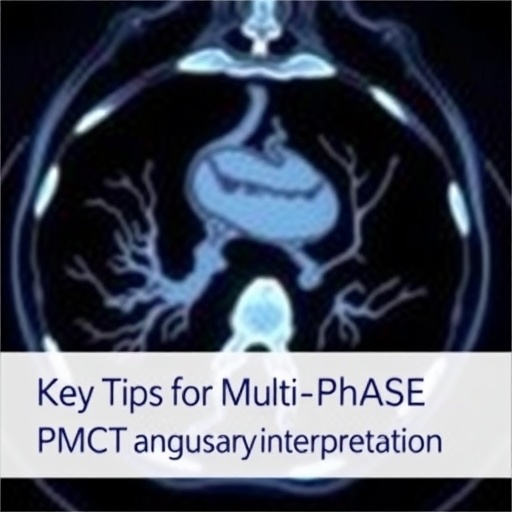In the evolving field of forensic medicine, the capacity to accurately diagnose causes of death through non-invasive imaging techniques has witnessed remarkable advancements. Among these, post-mortem computed tomography angiography (PMCTA) has emerged as a transformative tool, offering unprecedented clarity and detail in vascular and tissue analysis after death. The latest breakthrough study by Wiskott, Magnin, Egger, and their colleagues, published in the International Journal of Legal Medicine, sheds light on novel diagnostic strategies for interpreting multi-phase PMCTA images in cases of upper gastrointestinal (GI) bleeding. This research not only enhances the forensic diagnostic arsenal but also pushes the boundaries of medical imaging technology applications in post-mortem investigations.
Upper GI bleeding is a critical and potentially fatal medical condition that, in forensic contexts, often poses significant challenges regarding the determination of hemorrhage origin and extent. Traditional autopsy techniques, while thorough, can sometimes fall short in accurately delineating vascular sources and bleeding dynamics, especially when decomposition complicates the analysis. The study conducted by Wiskott et al. capitalizes on the multi-phase capability of PMCTA to provide a dynamic and layered understanding of vascular perfusion and leakages that underpin bleeding episodes, thereby rendering far more reliable post-mortem diagnoses.
Multi-phase PMCTA involves multiple sequential scans after the injection of contrast agents into the vascular system, allowing forensic experts to visualize the contrast agent’s temporal distribution through arteries, capillaries, and veins. This dynamic imaging technique offers a temporal dimension to post-mortem vascular studies, revealing pathological vascular permeabilities and patencies that static imaging or traditional autopsy might miss. By exploiting this technology specifically for upper GI bleeding, the authors provide detailed diagnostic protocols that enhance interpretative accuracy, highlighting subtle findings that could be critical for forensic conclusions.
A crucial aspect of the study is its meticulous delineation of the arterial and venous phases during PMCTA, which helps distinguish active bleeding sites from post-mortem artifact or inert fluid collections. The differentiation is vital because post-mortem changes frequently mimic hemorrhagic presentations, leading to potential misinterpretations. The multi-phase imaging protocol, as described by Wiskott and colleagues, enables the mapping of contrast extravasation over time, pinpointing regions of active vascular compromise and facilitating differentiation between ante-mortem hemorrhages and post-mortem redistribution of fluids.
The research harnesses advanced image reconstruction techniques to optimize visualization, including volume rendering and multiplanar reconstructions, which transform raw angiographic data into clinically and forensically meaningful images. These refined images aid forensic radiologists and pathologists in navigating the complex vascular architecture of the upper GI tract, which includes intertwined arteries such as the celiac trunk, hepatic artery, and their branches. The enhanced visualization capacity assists in identifying subtle vascular injuries, ulcerations, or ruptures not readily apparent with previous imaging modalities.
Delving deeper into the technicalities, the study emphasizes appropriate contrast agent selection and administration protocols to maximize the contrast-to-noise ratio essential for clear imaging of the upper GI vasculature. The authors underline the importance of timing and volume parameters tailored to post-mortem physiology, which differs drastically from living subjects. This optimization is a cornerstone of the diagnostic tips presented, as it ensures consistent and reproducible imaging quality, a prerequisite for trustworthy forensic interpretation.
One of the groundbreaking insights from this research lies in its approach to interpreting signs of hemorrhage within varying post-mortem intervals. The authors demonstrate that the temporal phase behavior of contrast agent leakage correlates not only with the site of vascular injury but also with the elapsed time since death. By leveraging this correlation, forensic practitioners can glean information about hemorrhage timing, an invaluable forensic parameter that can establish timelines in medico-legal investigations.
The study also addresses challenges in discerning true bleeding sites from pseudo-leaks, a common complication in PMCTA diagnosis caused by post-mortem gas formation and tissue decomposition. Through a set of interpretive criteria, the authors guide forensic experts in distinguishing these phenomena, thereby avoiding misdiagnoses that could have profound legal implications. This methodological rigor significantly elevates the reliability of PMCTA in forensic pathology, underpinning its growing acceptance in legal medicine.
Importantly, the research explores the integration of PMCTA findings with traditional autopsy information, fostering a multidisciplinary approach to forensic investigation. The authors argue that PMCTA should not supplant autopsy but rather complement it, offering a more comprehensive diagnostic toolkit. This synergy is particularly relevant in complex cases of GI bleeding where vascular injury might be subtle or obscured by post-mortem changes. The multi-phase PMCTA provides a preliminary vascular roadmap, which autopsy can then verify and augment with histological findings.
From a forensic procedural standpoint, the study pioneers standardized protocols for the acquisition, reconstruction, and interpretation of multi-phase PMCTA in upper GI bleeding. These protocols are detailed with respect to patient positioning, contrast injection rates, scanning timing, and post-processing workflows. The standardization promises to harmonize PMCTA usage across forensic centers globally, enabling comparative data analyses and fostering consistent case resolution practices.
The authors also critique existing literature and forensic imaging practices, identifying knowledge gaps that their study begins to fill. They emphasize the necessity of dedicated training for forensic radiologists in multi-phase PMCTA interpretation, advocating for enhanced educational programs that incorporate these advanced imaging principles. The research thereby serves not only as a diagnostic guide but also as a foundational text for evolving forensic imaging curricula.
Beyond technical and practical advances, this research signals a paradigm shift in forensic pathology towards less invasive and more technologically driven procedures. Multi-phase PMCTA, as championed by Wiskott and team, reduces the need for extensive dissection, preserving body integrity while delivering comprehensive diagnostic data. The implications for ethical considerations in forensic practice are profound, balancing scientific rigor with respect for the deceased.
Looking ahead, the study opens avenues for further research into the application of multi-phase PMCTA to other post-mortem bleeding scenarios beyond the upper GI tract. The principles and techniques outlined have potential to revolutionize how various hemorrhagic deaths are investigated, from traumatic injuries to vascular ruptures in diverse anatomical regions. This extensibility solidifies the study’s impact and invites collaborative research initiatives to refine and validate these methods broadly.
Technological innovation is another theme underscored by the study, which anticipates integration of artificial intelligence and machine learning algorithms in future PMCTA analysis pipelines. Such technologies could automate the detection of vascular leaks and hemorrhagic patterns, increasing diagnostic speed and reducing human error. Wiskott et al.’s work lays a critical groundwork for these advancements by establishing reliable interpretive criteria and imaging standards.
In the broader medical and legal context, the study contributes to enhancing the evidentiary value of post-mortem imaging, strengthening the role of forensic radiology as a cornerstone of medico-legal investigations. This enhancement is particularly pertinent in jurisdictions where autopsy consent is limited or where non-invasive methods are preferred for cultural or religious reasons. Multi-phase PMCTA offers a compromise that upholds investigative rigor without compromising respect for community values.
The meticulous approach and comprehensive scope of the study are exemplified in its detailed case illustrations, which showcase representative images of upper GI bleeding from multi-phase PMCTA scans. These visual exemplars serve as both educational material and practical references, illustrating the nuances of contrast distribution, vascular damage localization, and differential diagnosis. For forensic practitioners, these case studies are invaluable for honing interpretive skills and improving diagnostic confidence.
Overall, the research by Wiskott and colleagues marks a significant leap forward in forensic imaging technology and methodology. By elucidating diagnostic tips for multi-phase PMCTA interpretation specifically tailored to upper GI bleeding, the study offers a transformative resource that enhances diagnostic precision, procedural standardization, and forensic integrity. As post-mortem imaging continues to evolve, this work stands as a landmark contribution that will undoubtedly influence forensic practice and education for years to come.
Subject of Research: Diagnostic strategies and imaging protocols for multi-phase post-mortem computed tomography angiography in cases of upper gastrointestinal bleeding.
Article Title: Diagnostic tips for multi-phase post-mortem computed tomography angiography interpretation in upper gastro-intestinal bleeding.
Article References:
Wiskott, K., Magnin, V., Egger, C. et al. Diagnostic tips for multi-phase post-mortem computed tomography angiography interpretation in upper gastro-intestinal bleeding.
Int J Legal Med (2025). https://doi.org/10.1007/s00414-025-03593-0
Image Credits: AI Generated
Tags: advances in medical imaging technologychallenges in forensic diagnosticsdiagnostic strategies for PMCTAforensic medicine imaging techniqueshemorrhage determination in forensicsinterpreting angiography images in forensicsmulti-phase PMCT angiographynon-invasive autopsy alternativespost-mortem computed tomography applicationspost-mortem diagnosis methodsupper gastrointestinal bleeding analysisvascular imaging in forensics





